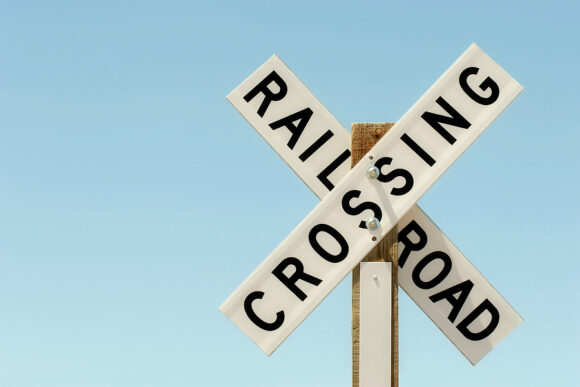A series of crashes involving trains and passenger vehicles – including deadly collisions in New York and California last month – have prompted police to ramp up ticket enforcement at railroad crossings.
The Federal Railroad Administration has called for police departments nationwide to add patrols and issue more citations as the first step in a safety campaign, and drivers in the New York suburbs are already seeing the results.
 Police from the Metropolitan Transportation Authority are issuing six times as many summonses as they did last year to drivers who go around gates, stop on the tracks or drive distracted at grade crossings on the Metro-North and Long Island commuter railroads, spokesman Aaron Donovan said. Officers wrote out 249 tickets between Jan. 1 and March 22, compared with 41 in a similar period last year.
Police from the Metropolitan Transportation Authority are issuing six times as many summonses as they did last year to drivers who go around gates, stop on the tracks or drive distracted at grade crossings on the Metro-North and Long Island commuter railroads, spokesman Aaron Donovan said. Officers wrote out 249 tickets between Jan. 1 and March 22, compared with 41 in a similar period last year.
“Ninety-four percent of grade crossing accidents are linked to a driver’s behavior,” said Sarah Feinberg, the Railroad Administration’s acting administrator.
On Feb. 3, a Metro-North train slammed into an SUV on the tracks in suburban Valhalla, killing the SUV driver and five train passengers. Since then, a Metrolink commuter train struck a pickup truck in Oxnard, California, fatally injuring the engineer, and an Amtrak train slammed into a tractor-trailer in Halifax, North Carolina, injuring 55 people. On Saturday, a light rail train in Los Angeles struck a car that turned in front of it outside the University of Southern California, seriously injuring the driver and train operator and leaving 19 other passengers hurt.
At least two other train-car collisions resulted in injuries in the New York suburbs in the past month, but that’s not unusual. The Railroad Administration noted more than 10,000 crashes at railroad crossings in the past five years, causing 1,211 deaths and 4,644 injuries.
“This is where people are getting killed; this is where the danger is,” said U.S. Rep. Sean Patrick Maloney, of New York. He has asked the Railroad Administration for a “deep dive” investigation to determine the nation’s most dangerous crossings and which safety devices are best at preventing collisions.
Maloney recently helped push legislation through the House that would make $300 million available to allow local governments to make safety improvements at rail crossings or eliminate them. Crossing-safety bills have also been proposed in the U.S. Senate and the New York Senate.
The Railroad Administration announced its safety campaign March 3, telling police groups that the casualty numbers were “unacceptable.”
‘Nobody likes to get a ticket, but enforcement is part of education, and educating the public is important in railroad crossing safety,” said Police Chief Paul Oliva, of Mount Pleasant, which includes Valhalla.
Feinberg said the Railroad Administration will conduct an audit to determine how many law enforcement agencies respond. But many jurisdictions are already running ticketing campaigns.
On Wednesday, police from the Union Pacific Railroad and local departments issued 51 citations in five hours along the stretch of track in Oxnard where the Feb. 24 Metrolink collision occurred, Union Pacific spokesman Francisco Castillo said. Some of the police officers watched for violations from the motorman’s cab.
The next day, Idaho state police issued 47 citations for crossing violations near Boise, a spokeswoman said.
Among the offenses police look for is a driver trying to cross tracks before there’s room on the other side. On the night of the Metro-North crash, traffic was backed up because of a detour, and the SUV driver was in the crossing when the warning gates came down.
Steve Heller, of Valhalla, who travels the crossing twice a week, said he didn’t find it unsafe.
“You just have to be aware of your surroundings,” he said after driving over in view of two MTA officers. “The signs are there, the gates are there. You don’t stop on the tracks. You don’t cross until you know you can get across. It’s a basic driving skill.”
But Joyce Rose, president and CEO of Operation Lifesaver, thinks it may be a fading skill. The nonprofit, which focuses on rail safety education, is expanding its partnership with the MTA.
“People have to know what these warning signs and devices mean and what they’re supposed to do when they see them,” Rose said. “I think sometimes people don’t know. They may not have been taught in drivers ed or they may have forgotten, or they’re impatient or they’re distracted.”
Though it’s generally suspected that the cause of the Valhalla crash was driver’s error, the National Transportation Safety Board said the finding of a probable cause for the accident is still a year away.
(Associated Press news researcher Monika Mathur in Washington contributed to this report.)
Was this article valuable?
Here are more articles you may enjoy.


 Surging Oil Tanker Insurance Points to Growing Black Sea Chaos
Surging Oil Tanker Insurance Points to Growing Black Sea Chaos  Musk’s X Probed by UK Over Grok’s Thousands of Sexualized Images
Musk’s X Probed by UK Over Grok’s Thousands of Sexualized Images  JPMorgan Wins Gender Pay Gap Dispute Against London Analyst
JPMorgan Wins Gender Pay Gap Dispute Against London Analyst  Billionaire NFL Owner Suing Over Billboards Near His SoFi Stadium
Billionaire NFL Owner Suing Over Billboards Near His SoFi Stadium 